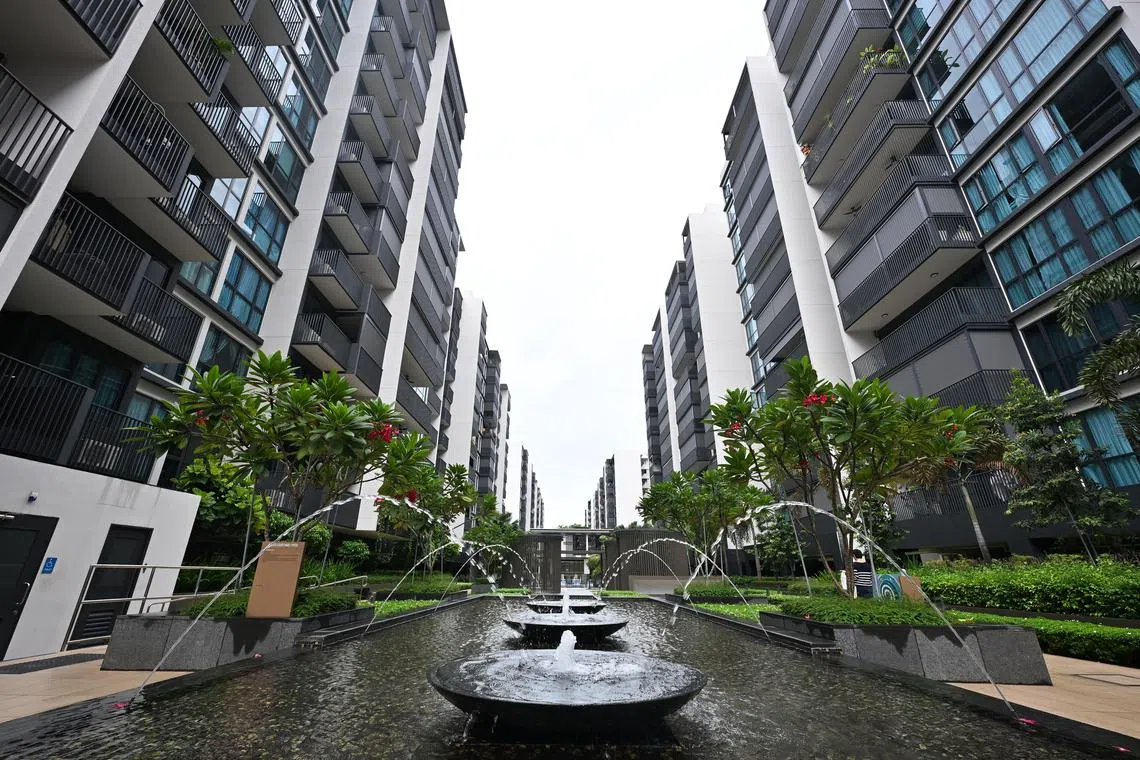Leasehold condos gain ground, profitability gap with freehold shrinks
Sign up now: Get ST's newsletters delivered to your inbox

Beyond profitability, the price gap between freehold and leasehold condos in Singapore has closed over the past decade, noted a researcher.
ST PHOTO: LIM YAOHUI
Follow topic:
SINGAPORE – Leasehold condominiums are becoming nearly as profitable as freehold units, with some even outperforming the latter in certain areas, according to a study of transaction data by ERA Singapore.
The findings suggest that factors such as proximity to MRT stations and urban amenities are playing a bigger role in determining property value than tenure alone.
Leasehold condos typically come with a 99-year tenure, after which the ownership of the land reverts back to the Government or the original land owner.
The ERA Research and Market Intelligence study analysed 7,032 transactions involving condo units bought and sold between 2015 and 2024 across 765 projects within a 2km radius of nine MRT stations.
The stations were Katong Park, Great World, Marymount, Beauty World, King Albert Park, Outram Park, Potong Pasir, Serangoon and Tampines East. The condo developments shortlisted had at least 30 resale transactions in the period of study, which excluded executive condominiums.
In three locations – Katong Park, Serangoon and Potong Pasir – leasehold condos achieved higher median profits than their freehold counterparts.
Near Katong Park MRT station, leasehold condos recorded a median profit of $280,000, while freehold units lagged behind at $200,000.
A similar trend was observed near Serangoon MRT station, where leasehold units saw a median profit of $240,600, compared with $171,016 for freehold units. In Potong Pasir, leasehold units posted a median profit of $175,000, surpassing the $140,000 median profit for freehold units.
The overall median profit for freehold condo units exceeded leasehold units by $118,568 in 2019.
By 2023, the gap had shrunk to just $35,350, and narrowed further to $30,000 in 2024.
“A likely reason for this trend is the higher transaction volumes seen in leasehold developments, which has helped to buoy price growth,” said ERA Singapore’s head of research and market intelligence Wong Shanting.
She added that the growing number of leasehold developments near MRT stations allows them to command a price premium, particularly in mature estates where demand remains strong.
Some of the most profitable leasehold projects include Treasure at Tampines, which recorded 484 transactions with a median profit of $231,500, and Jadescape near Marymount MRT station, which saw 180 transactions with a median profit of $331,944.

Some of the most profitable leasehold projects include Treasure at Tampines, which recorded 484 transactions with a median profit of $231,500.
ST PHOTO: LIM YAOHUI
Despite these gains, freehold condos still hold a profitability advantage in prime locations with fewer new launches.
Freehold projects located in the central region near Outram Park MRT station had a median profit of $230,000, which was $136,400 higher than the $93,600 median profit for leasehold projects.
The gap was even wider near Great World MRT station, where freehold units recorded a median profit of $350,000, which was $243,000 more than the $107,000 median for leasehold units.
Shrinking price gaps
Beyond profitability, the price gap between freehold and leasehold condos has closed over the past decade, noted Ms Christine Sun, chief researcher and strategist at property firm OrangeTee Group.
Islandwide, the median price of freehold condos was $1,435 per sq foot (psf) in 2014, which was 20.7 per cent higher than the median price of leasehold condos at $1,189 psf, Ms Sun noted, citing Urban Redevelopment Authority data.
This trend has now reversed. In 2024, the median price of freehold condos stood at $1,903 psf, while leasehold condos were priced at $1,973 psf or 3.7 per cent higher than freehold units, pointed out Ms Sun.
She explained that the shift could be attributed to the strong price growth of leasehold condos over the past decade, with their values surging by 65.9 per cent. Prices of freehold condos, in comparison, rose by 32.6 per cent, said Ms Sun.
“More home buyers are prioritising convenience and accessibility to essential amenities, thus they are willing to give up the freehold status for a leasehold property,” said Ms Sun.
She added that the high costs of owning a car in Singapore have also helped to drive demand for homes near to MRT stations.
However, high-net-worth individuals remain firm on freehold properties, especially in prime areas like District 10, said property agent Stefanie Wong of Singapore Realtors Inc.
These buyers see freehold properties as secure assets to pass down to future generations.
In contrast, mass-market buyers in the outside central region (OCR) prioritise affordability. These buyers often adopt a shorter investment horizon, typically around five years, with a focus on resale potential rather than long-term ownership, said Ms Wong.
While leasehold properties in good OCR locations with strong amenities can be highly sought after and profitable, those in prime districts like 9, 10 and 11, where most properties are freehold or 999-year leasehold, struggle to attract buyers.
Buyers in these prime locations tend to be high-net-worth individuals who prefer freehold properties for legacy planning. Since many freehold options are available, leasehold units become less attractive, making them harder to sell, said Ms Wong.
Additionally, buyers in prime districts are typically long-term holders rather than short-term investors, reducing resale activity, she added.
Looking ahead, the supply dynamics of both leasehold and freehold condos could further shape market trends, said ERA Singapore’s key executive officer Eugene Lim. While the release of Government Land Sales sites continues to drive leasehold property price growth, the dwindling number of collective sales means freehold supply remains limited.
“Freehold properties will still likely hold their price better than leasehold properties, which are subject to lease decay in the long term,” said Mr Lim.
He cautioned that the appeal of such units drops as the remaining lease shortens over time, making it harder for buyers of older properties to secure full loans. This can limit buyer demand and slow price growth over time.


